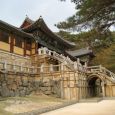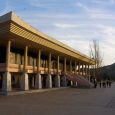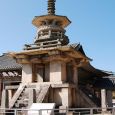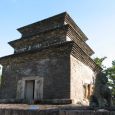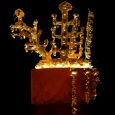Gyeongju
Advertisement
By plane
Gyeongju doesn't have its own airport. The nearest are in Busan (Gimhae) and Ulsan, both an hour away by express bus. Bus service between the airports and Gyeongju's main terminal runs hourly. There are also 5 direct return coach journeys per day between Seoul Incheon Airport and Gyeongju Intercity Bus Terminal. These services take around 4 hours and cost around 40000 Won each way.
By train
Gyeongju station is located in the city centre, and is served by 7 direct (but slow) Seamaeul trains per day from Seoul. These trains take up to five hours and stop at a large number of stations along the route. An alternative option is to take the KTX high speed train to Dongdaegu and transfer to the Saemaeul there, which takes about 3 hours plus transfer time.
The KTX (Korea's high speed train) also serves Gyeongju directly, although the train goes to the brand new out-of-town station called Singyeongju. The journey time from Seoul is 2:05. From the new station, many buses will take you to the city in about 15 minutes. Use buses 50, 60, 61, 70, 203 and 700. Ask the driver to let you off at the Express Bus Terminal (Gosok Teominal) which is a pretty convenient location. One way economy class Seoul-Singyeongju by KTX costs a little over 40000 Won, and tickets can be purchased from the automated machines (in English or Korean) at the station
By bus
Gyeongju is well serviced by intra-city buses. Service from Daegu, Pohang, and Busan (depending on terminal) leaves at least every twenty minutes, and every 40 minutes between Gyeongju and Seoul. Travel time from Seoul is approximately four hours, and Daegu, Pohang, and Busan are usually 40 minutes to an hour. There is limited daily service to other parts of Korea, and travelers going between Gyeongju and other cities will usually be routed through either Daegu or Busan, depending on direction of travel. An inter-city bus leaves directly from the Incheon International Airport near Seoul.
Advertisement
Bulguksa Temple
A wonderful temple well outside the main city. It can be reached by bus every half-hour. Try to go in the early morning when there are less tourists. It's a humongous working temple so treat the site with the respect it deserves. Possibly the most impressive temple in Korea. It is regarded as a masterpiece of Buddhist art, and was built in the 8th century during the Silla Kingdom period.
In front of the main prayer hall, there stand two famous stone pagodas. They are both National Treasures. Dabotap means the pagoda of many treasures. Standing on the right of the courtyard facing the main hall, it shows the artistic beauty of Silla culture. In comparison to the simple Seokgatap, it is highly decorative. It was so delicately carved that they say ‘Silla masons managed stones like clay.’
Seokguram Grotto
The grotto is an amazing site, not to be missed. A few kilometers hike up from the Bulguksa Temple, or a 20 minute bus ride that leaves every hour at 40 minutes past the hour and then goes back to the temple every hour on the hour, you will find this national treasure. This is a classic example of high Silla art and architecture, a spectacular Buddhist site. One will ecounter a seated Buddha protected by two sets of 12 royal guards. On the soltice the third-eye of the Buddha is hit by a ray of the sun coming through the dome above his head. The light from the third eye is said to shine South-south-East, in the direction of an ancient temple in the valley below, destroyed by Mongols in the 13th century. The line continues and points exactly to the tomb of King Mum-Mu in the East Sea, 3km father South-south-East. This was said to protect Korea from Japan. Although the grotto is behind a panel of glass, this is to protect it from the breath of thousands of daily tourists. Photography is not permitted inside the grotto due to the sacred nature of the site. The site may best be left for a clear day otherwise you will miss out on some great views.
Seokgatap
Seokgatap means the pagoda of Buddha. It stands on the left of the courtyard facing the main hall. This three story pagoda is admired for its simple and dignified design. It is considered Korea’s most typical stone pagoda.
Royal Tombs
Royal Tombs There are many royal tombs including: The Gwoereung Tomb, Oreung Tombs Park, Baeri Samneung Tombs, Gyeongju Hwangnam-ri Gobungun Tomb Park, Nodong/Noseo-ri Tombs Park, Seoakri Gobungun Tombs Park, Kim Yushin's Tomb, King Munmu's Underwater Tomb.
The Wolseong Yangdong Village
The Wolseong Yangdong Village has 150 tile roof houses and thatched cottages. Some are 500 years old. Interesting examples of old Korean architecture. Take bus number 203 from the Express Bus Terminal, it runs right to the village entrance and costs 1500 Won.
The stone pagoda Dabotap
The stone pagoda Dabotap, also known as pagoda of many treasures, is located in the temple of Bulguksa in Gyeongju, South Korea. From entering the temple through the Cheongun and Baegun Bridge, Dabotap is located on the right side, opposing Seokgatap on the left side. The pagoda is supposed to have been built in 751, the 10th year of the Shilla king Gyeongdeok. It is currently designated as National Treasure no. 20.
The 3 story pagoda stands 10.4 meters tall and was built in an ornate style not seen in other Buddhist countries. The sculpture techniques used are unique for its time and include delicate features.
Bunhwangsa
Bunhwangsa literally "Fragrant Emperor Temple" is a temple complex from the Old Silla era of Korea. It is located in Gyeongju. The temple is recorded to have been built in 634 under the auspices of Queen Seondeok.Today the temple is still used by a small group of worshipers but in its heyday, the temple covered several acres and was one of the four main temples of the Silla Kingdom used by the state to ask the Buddha to bless the kingdom. The ruins of Hwangnyongsa Temple lay nearby.
Tohamsan
Toham Mountain, or Toham-san, is a mountain with a height of 745m in Gyeongju City in southeastern South Korea. It is part of the minor Dongdae Mountains range. The mountain lies within Gyeongju National Park and is the site of a large number of historic relics. The Silla-era Buddhist shrines of Bulguksa and Seokguram are located on its slopes. The mountain stands at the intersection of three subdivisions of Gyeongju: Bulguk-dong, Bodeok-dong, and Yangbuk-myeon. The Sea of Japan (East Sea) can be seen from the peak, as can Gyeongju Basin which includes the city center
Silla
Silla (57 BC – 935 AD) was one of the Three Kingdoms of Korea, and one of the longest sustained dynasties in Asian history. Although it was founded by King Park Hyeokgeose, who is also known to be the originator of the Korean family name Park the dynasty was to see the Gyeongju Kim clan hold rule for most of its 992-year history. What began as a chiefdom in the Samhan confederacies, once allied with China, Silla eventually conquered the other two kingdoms, Baekje in 660 and Goguryeo in 668. Thereafter, Unified Silla or Later Silla, as it is often referred to, occupied most of the Korean Peninsula, while the northern part re-emerged as Balhae, a successor-state of Goguryeo. After nearly 1000 years of rule, Silla fragmented into the brief Later Three Kingdoms, handing over power to its successor dynasty Goryeo in 935
Gyeongju National Museum
The Gyeongju National Museum is a museum in Gyeongju, North Gyeongsang Province, South Korea. Its holdings are largely devoted to relics of the Silla kingdom, of which Gyeongju was the capital.
The museum is located immediately adjacent to the royal tomb complex, in an area which also includes the Gyerim forest, Cheomseongdae observatory, Banwolseong palace, and Anapji Pond.
Information not available
Information not available
Advertisement

